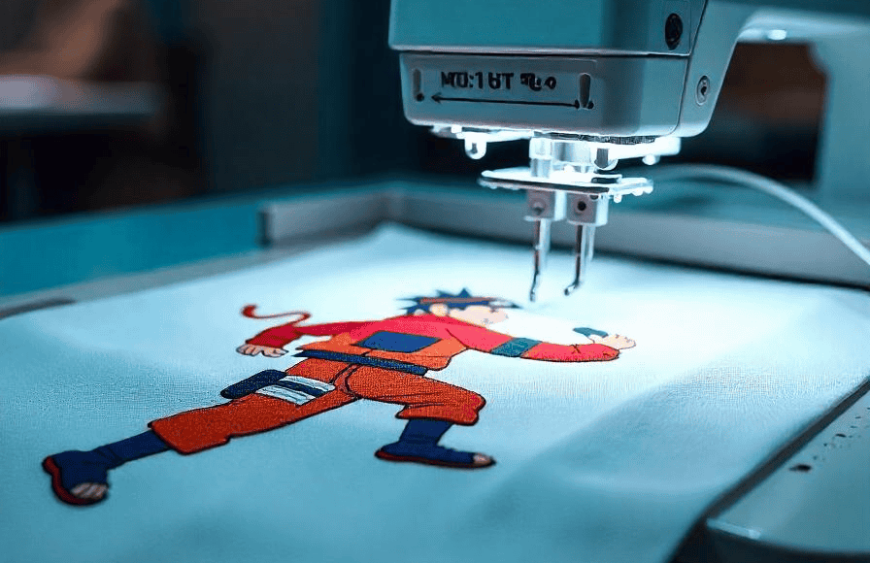Starting Your Own Custom Embroidery Business

Starting Your Own Custom Embroidery Business
Embroidery is an art form that has been cherished for centuries. Today, it’s not just a hobby but a profitable business venture.
Starting your own custom embroidery company can be a rewarding endeavor. It allows you to express your creativity while earning a living.
But where do you begin? How do you transform a passion for embroidery into a thriving business?
This guide will provide you with a roadmap. It covers everything from understanding the market to marketing your services.
Whether you’re wondering where to get clothes embroidered or how to offer high-quality embroidery, we’ve got you covered.

Embark on this exciting journey with us. Let’s explore the world of custom embroidery business together.
Understanding the Custom Embroidery Market
The custom embroidery industry has seen significant growth. Rising demand for personalized products fuels this expansion. It’s an excellent time to dive in.
Identifying a niche is crucial for success. Some focus on corporate custom logo embroidery. Others may cater to personalized gifts or clothing.
Research your target audience thoroughly. Understand their needs and preferences. This helps tailor your product offerings effectively.
Stay informed about market trends. Follow industry updates and listen to customer feedback. Adapting to changes keeps your business relevant.
Finally, keep an eye on competitors. Identify what sets your custom embroidery company apart. Use this to differentiate and thrive.
Crafting Your Custom Embroidery Business Plan
Starting with a solid business plan is essential. It acts as a roadmap for your custom embroidery company. Outline your goals and strategies clearly.
Begin with a detailed market analysis. Understand the demand and identify potential competitors. Knowing your market helps shape effective strategies.
Define your business model next. Decide whether you’ll operate online or have a physical store. Consider factors such as initial costs and operation logistics.
Include financial projections to estimate costs and revenues. Determine your pricing strategy to stay competitive. Offering high-quality embroidery can be a unique selling point.
Finally, focus on your marketing and sales strategy. Highlight how you will promote your custom embroidered apparel. Consider channels like social media and partnerships.
Key elements in your plan:
- Market analysis and customer demographics
- Business model and location decision
- Financial projections and pricing strategy
- Marketing and sales approach
- Goals and success metrics
A comprehensive plan sets your business foundation.
Legal and Financial Considerations
Starting a custom embroidery business involves several legal steps. Begin by registering your company. Decide on the business structure, such as an LLC or sole proprietorship.
Secure any necessary licenses or permits. These requirements vary by location and business type. It’s vital to comply with local regulations to avoid issues.
Budgeting is a critical financial step. Outline expected expenses, from equipment to marketing. Keep track of ongoing costs to maintain control over your finances.
Consider consulting a financial advisor. They can help with tax planning and investment decisions. Proper financial management ensures your business remains profitable.
Investing in Embroidery Equipment and Software
High-quality equipment is crucial for a custom embroidery business. Invest in reliable embroidery machines that suit your production needs. Quality machines ensure precision and efficiency.
Alongside machines, select robust software. Software helps design intricate patterns and manage orders. Advanced programs offer customization options that appeal to clients.
Consider your budget when choosing equipment. Top-tier machines may be costly, but they offer long-term benefits. Evaluate the features and longevity before purchase.
Training is essential to maximize equipment use. Familiarize yourself with machine functions. Proper handling minimizes errors and boosts productivity.
Developing Your Embroidery Skills
Embroidery skills are fundamental to any custom embroidery business. Master different stitching techniques to produce varied and appealing designs.
Practice is key to honing your craft. Dedicate time to refine your techniques and experiment with new patterns regularly.
Consider taking online courses or attending workshops. These resources can introduce innovative methods and keep your skills current.
Stay updated with industry trends. Adapting to new styles and techniques ensures your business remains competitive and attracts more clients.
Sourcing Your Materials and Setting Up Shop
Finding reliable suppliers for embroidery materials is crucial. Ensure materials are high-quality to produce the best results. This reinforces your brand’s reputation.
Evaluate different suppliers to get the best deals. Bulk purchasing can save you money if your orders increase.
Create a dedicated space for your business. Ensure your workspace is organized and accommodates all your equipment and materials comfortably.
Arrange your tools and supplies efficiently. This minimizes workflow interruptions and enhances productivity, leading to more completed projects.
Pricing Strategies for Embroidered Merchandise
Setting competitive prices is essential for your custom embroidery company. Research industry standards to ensure your rates align with market expectations.
Consider production costs, including materials and labor. Accurate pricing ensures profitability while staying competitive in the embroidery market.
Offer tiered pricing for bulk orders. Discounts for larger orders can attract business clients seeking embroidered merchandise.
Regularly review your pricing strategies. This allows you to adjust to market trends and continue offering appealing prices.
Marketing Your Custom Embroidery Services
Promoting your custom embroidery company is crucial for attracting clients. Utilize multiple channels for a broader reach and varied customer base.
Leverage social media platforms like Instagram and Facebook. Share photos of your embroidered merchandise to engage potential customers and showcase your skills.
Collaborate with local businesses for mutual promotion. This helps in accessing their customer base and increasing local visibility.
Participate in trade shows and craft fairs. These events offer opportunities to meet clients face-to-face and demonstrate your high-quality embroidery work.
Consider using online advertising to reach specific demographics. Tailor your ads to target those interested in custom logo embroidery and personalized apparel.
- Utilize social media for showcasing work.
- Collaborate with local companies for added exposure.
- Engage in craft fairs for direct promotion.
- Use online ads to target specific markets.

Building an Online Presence
A strong online presence is vital for the success of any custom embroidery company. It allows you to reach a wider audience and establish credibility in the industry.
Start by creating a professional website. Ensure it showcases your best custom embroidery products and provides clear information about your services.
Leverage SEO techniques to improve your website’s visibility on search engines. This helps attract more visitors searching for embroidery services.
Consider setting up a shop on an e-commerce platform. This allows you to sell custom embroidered apparel directly to customers, expanding your market reach.
Expanding Your Product Range and Services
Diversifying your offerings is key to business growth in the embroidery industry. Explore new product categories like embroidered merchandise and custom embroidery clothing.
Consider providing single item embroidery services. This caters to customers who seek personalization for specific clothing or items.
Investigate collaborations with local businesses. They may need custom logo embroidery for uniforms or promotional merchandise.
Adapting to trends is essential for staying competitive. Offer seasonal products or themed collections to meet the changing preferences of your customers.
Maintaining High-Quality Standards
High quality embroidery is vital for customer satisfaction. Focus on precision and detail in every stitch.
Regularly inspect your work for consistency. Ensure every piece meets a high standard before it reaches the customer.
Stay updated with industry advancements and techniques. This will help you maintain excellence and improve your embroidery skills over time.
Networking and Building Industry Relationships
Building a network in the embroidery industry is crucial. Engage with other businesses, artisans, and suppliers in your community.
Attend trade shows and craft fairs. These events are perfect for meeting potential partners and learning about the latest industry trends.
Join embroidery and apparel associations. These groups offer resources, support, and opportunities to forge valuable connections.
Conclusion: The Path to Embroidery Success
Starting a custom embroidery company presents exciting challenges and opportunities. Success requires dedication, creativity, and strategic planning.
By following industry trends and adapting, your embroidery business can thrive in a competitive market.










